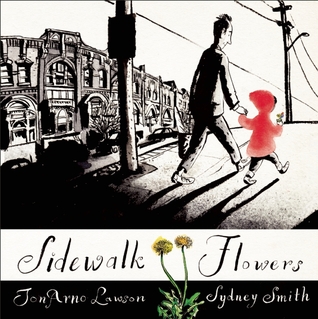This beautiful wordless picture book is the winner of the
2015 Cybils Award in the Fiction Picture Book category! I am so proud to have been a part of the judging process to choose this lovely book as the winner.
One of the things that surprised me the most about it was that even though it's a wordless book, there was a writer as well as an illustrator. In Canada, this
book won a Governor General's Literary Award for Children's Illustrated Books
2015. It was also selected for the New York Times Best Illustrated Children's
Books of the Year 2015.
In this wordless picture book, a little girl collects
wildflowers while her distracted father pays her little attention. Each flower
becomes a gift, and whether the gift is noticed or ignored, both giver and
recipient are transformed by their encounter.
Written by award-winning poet JonArno Lawson and brought to
life by illustrator Sydney Smith, Sidewalk Flowers is an ode to the importance
of small things, small people and small gestures.
Sidewalk Flowers was published by Groundwood Books in 2015.
My Thoughts as a
Writer:
I found it very interesting that even though this is a
wordless book, a writer created the story. I loved the idea that to really
appreciate this book, you need to stop and look, which is what the girl is
doing in the story. A post from Groundwood explains how this book came to be and the author's role in the process.
I really loved the simple, pen and ink drawing style and the effectiveness of the growing use of colour. I noticed the realistic expressions on the girl’s
face, showing the pure pleasure she gets from finding and giving flowers. There
is so much lovely detail in the illustrations, it is a book you can return to
and explore again.
My Thoughts as a
Teacher:
Although this book may be more effective in a small group or
one-on-one than in a class read aloud, I really liked the subtle encouragement
to stop and notice, to give without expecting anything in return. Because it is
wordless, this book is accessible to all sighted students, no matter what
language they speak.
In sharing this with a group, I would probably “read”
through the book by showing each page slowly, then go back and “re-read”, this
time describing with students what is happening on each page.
Ages: 3 –
7
Grades: preschool
and up
Themes: nature,
kindness, giving,
Activities:
Create a black and white drawing showing a scene you walk
past every day. Use a hint of colour to highlight something that people might
not normally notice.
Compare what the girl and the father are looking at as they
move through the story. Are there any changes as the story goes along? What do you think the author is trying to say? Does the story need words?
Choose your favorite page from the story. Explain why it’s
your favorite.
For older students, it would be interesting to read and
compare this book with The Man With the
Violin by Kathy Stinson and Dusan Petricic. Where does the illustrator
choose to add colour? Why?


No comments:
Post a Comment
I love to hear your responses and thoughts! Your comments will appear after moderation (I’ve decided to enable moderation due to excessive spam).